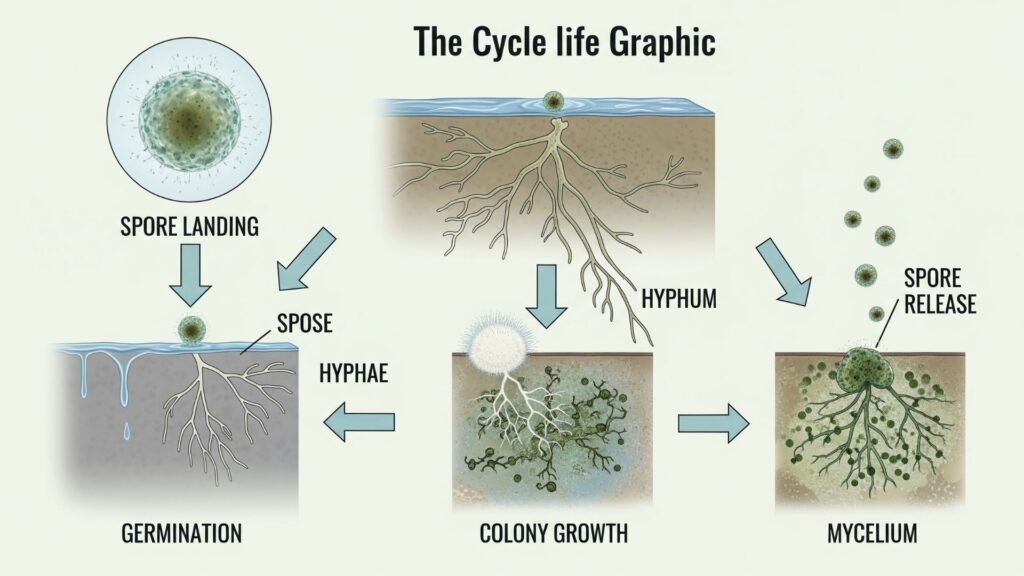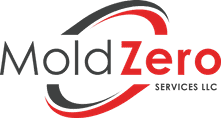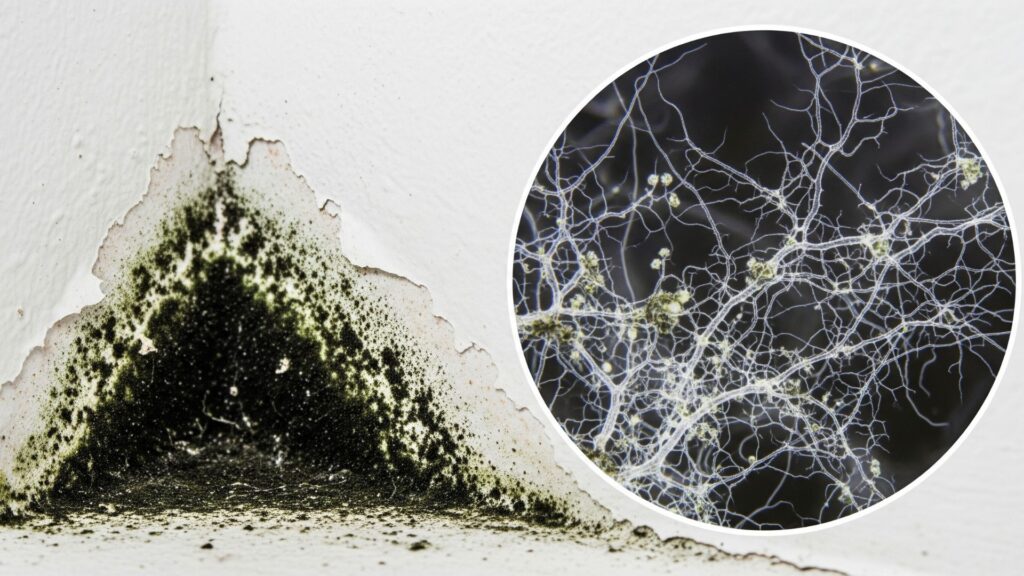Is Mold a Fungus? Uncovering the Truth About Your Home
The Simple Answer to a Common Question
Yes, mold is unequivocally a type of fungus. This places it in the same broad biological kingdom as mushrooms and yeast, but with distinct characteristics that make it a unique concern for property owners. While fungi play a crucial role in the natural world by breaking down organic matter, this same function becomes a significant problem when it happens inside your Los Angeles home or business.
Understanding that household mold is a fungus is the first step in realizing why it requires a professional response. At Mold Zero, our NORMI certified experts have addressed fungal growth in over 1,000 properties, providing us with unparalleled insight into how to properly manage these situations. We understand the science behind the growth and the precise steps needed to resolve it.
Why This Distinction Matters for Your Property
Recognizing mold as a living, growing organism from the fungi kingdom is critical. It’s not simply a stain that can be wiped away. As a fungus, it establishes a root-like network, known as mycelium, that grows into and feeds on building materials like drywall, wood, and insulation. This is why a surface-level approach is never enough. The visible discoloration you see is often just the “fruiting body” of a much larger, hidden colony.
Addressing the issue requires a comprehensive process that deals with the entire fungal system, both visible and hidden, to protect your property’s integrity. Ignoring the fungal nature of mold can lead to recurring problems and escalating damage. If you see or suspect mold, it’s a sign of an active fungal colony that needs immediate, expert attention. Contact Mold Zero at (626) 671-8885 for a free inspection to understand the extent of the issue in your property.
What is Mold and How Does It Relate to Fungi?
Defining the Fungal Kingdom
The Fungi Kingdom is a vast and diverse group of organisms separate from plants and animals. They are nature’s recyclers, playing an essential part in decomposing dead organic material. This kingdom includes everything from the mushrooms you see in a forest to the yeast used in baking. Molds are a specific group within this kingdom, characterized by their multicellular, filamentous structures. When we talk about fungal growth in homes, we are referring to these specific types of fungi. While their job outdoors is beneficial, their presence indoors signals a problem. They are simply doing what they are designed to do: consume organic materials to survive and reproduce. Unfortunately, in a home or business, those organic materials are the very structure of your property.
What Is Mold Made Of? A Microscopic View
To truly grasp what is mold, you have to look at its structure. A mold colony is composed of a few key parts. The main body is the mycelium, a web of tiny, thread-like filaments called hyphae. This is the part that grows into surfaces like wood or drywall, secreting enzymes to digest the material for nutrients. It’s the root system and the true heart of the colony. What you typically see on a wall or ceiling is the spore-producing part of the organism.
These structures produce microscopic spores, which are the reproductive units of the fungus. Spores are incredibly light and can easily become airborne, traveling through a property to find new, damp areas to begin new colonies. This is why understanding what mold is made of is crucial; a professional remediation plan must address the airborne spores and the embedded mycelium, not just the visible surface growth.
Is Household Mold a Fungus? The Unmistakable Answer
Let’s be perfectly clear: is household mold a fungus? Yes, 100% of the time. Whether it appears as black, green, or white patches, and regardless of the specific species (like Stachybotrys, Aspergillus, or Penicillium), it is a member of the fungal kingdom. There is no type of mold found in a property that is not a fungus. This fact dictates the entire approach to resolving the issue.
Because it is a living organism with a specific life cycle and needs, we can target those needs to manage the problem effectively. At Mold Zero, our deep expertise as NORMI certified professionals is built on this scientific understanding, allowing us to develop a process that addresses the fundamental biology of fungal growth in homes.
Understanding How Fungal Growth Starts in Homes
The Three Key Ingredients for Mold Growth
Mold is a resilient organism, but it cannot grow without three key ingredients coming together. Understanding this “mold triangle” is essential for both remediation and prevention. The most critical and controllable factor is moisture. Without water, mold spores cannot activate and begin to grow. Common moisture sources in Los Angeles properties include plumbing leaks, roof leaks, high indoor humidity, condensation on windows or pipes, and water intrusion from floods or poor drainage.
The second ingredient is a food source. Fungi are not picky eaters; they can feast on a wide array of organic materials found in every home, including wood, drywall paper, carpet backing, insulation, and even dust. The final ingredient is a suitable temperature. Most indoor environments, typically between 60 and 80 degrees Fahrenheit, are perfect for fungal growth. Since we can’t eliminate food sources or change the temperature, controlling moisture is the single most important strategy in managing mold.
From Spore to Colony: The Mold Life Cycle

The air, both indoors and out, naturally contains microscopic mold spores. They are dormant and generally inactive. The problem begins when one of these spores lands on a surface where the three key ingredients—moisture, food, and temperature—are present. Once a spore finds a damp spot on a piece of drywall, for example, it germinates. It sends out hyphae, which grow into a network (mycelium) within the material.
As this network expands and feeds, it eventually develops into a visible mold colony. At this stage, the colony matures and begins to produce and release its own spores into the air. This cycle can spread the problem to other damp areas of the property, creating new colonies and compounding the issue. This is why a small, ignored leak can quickly lead to a widespread problem, underscoring the need for a rapid response.
Why Los Angeles Properties Can Be Prone to Mold
Properties in Los Angeles and surrounding areas like San Marino face unique environmental factors that can encourage fungal growth. The proximity to the coast can lead to higher ambient humidity, especially during “May Gray” and “June Gloom.” Many homes feature construction styles, such as slab-on-grade foundations or stucco exteriors, which can trap moisture if not perfectly sealed or maintained. Older plumbing systems are also a common culprit for slow, undetected leaks within walls.
Our extensive experience, with over 1,000 remediation jobs in the region, has shown us all the common and uncommon ways moisture can impact a property. This local expertise allows us to quickly diagnose the source of the problem, which is the first step in our comprehensive solution. If you’re concerned about your property, call Mold Zero at (626) 671-8885 for an inspection from a team that truly understands Los Angeles buildings.
The Impact of Unaddressed Mold on Your Property
Structural Integrity at Risk
The primary function of a fungus is to decompose organic matter. When that fungus is growing in your home, it is actively decomposing your property. The mycelial network of a mold colony secretes digestive enzymes that break down materials like wood, paper, and other cellulose-based products.
Over time, this process can weaken wooden studs, rot drywall until it crumbles, and compromise the structural integrity of floor joists and roof sheathing. What might start as a small spot on a wall could be the visible sign of a much larger colony working to break down the essential components of your building. This is not just a cosmetic issue; it is a direct assault on the physical structure of your investment.
Aesthetic Damage and Property Value
Long before structural issues become apparent, fungal growth will cause significant aesthetic damage. Unsightly staining and discoloration on walls, ceilings, and floors are common early indicators. This growth can cause paint and wallpaper to peel, bubble, and chip. Beyond the visual impact, one of the most pervasive issues is the characteristic musty odor that mold produces. This smell can permeate carpets, furniture, and clothing, making the indoor environment unpleasant for occupants.
For homeowners, landlords, and business owners, these issues can have a severe financial consequence. The presence of mold can dramatically decrease a property’s market value, make it difficult to rent or sell, and can become a major point of contention during real estate transactions, often requiring professional remediation before a sale can close.
The Problem with DIY Approaches
Faced with visible mold, many property owners are tempted to try a do-it-yourself solution, often involving a sponge and a store-bought cleaning agent. This approach is almost always ineffective and can even make the situation worse. Simply wiping the surface does not address the underlying mycelial network that is rooted within the material.
Furthermore, scrubbing or disturbing a mold colony can cause it to release a massive cloud of spores into the air, potentially spreading the problem to previously unaffected areas of your home. These methods also fail to address the most critical part of the problem: the moisture source.
Without fixing the leak or humidity issue, the mold will inevitably return. Professional remediation is not just about cleaning a stain; it’s a scientific process designed to address the entire fungal system and the conditions that allow it to thrive.
The Mold Zero Solution: A Professional Approach
Why Our NORMI Certified Experts Make a Difference
When you’re dealing with fungal growth in your home, you need more than just a handyman; you need a certified specialist. Our team at Mold Zero consists of NORMI (National Organization of Remediators and Mold Inspectors) Certified professionals. This certification represents a rigorous standard of training and expertise in the science of mold assessment and remediation.
It means we understand the biology of mold, the proper procedures for handling it, and the standards for verifying a successful job. This expertise, combined with the practical knowledge gained from over 1,000 successful projects in Los Angeles, ensures that we don’t just treat the symptoms. We provide a comprehensive solution that addresses the root cause of the problem, giving you confidence that the job is done right the first time.
Our Unique 5-Step Process for Comprehensive Results
We have developed a highly effective and minimally invasive 5-step process that sets us apart. This systematic approach ensures every aspect of the fungal issue is addressed, from the hidden moisture source to the airborne spores. It’s designed to be fast, often completed in hours instead of days, minimizing disruption to your life. Our process includes:
- Step 1: Detailed Inspection & Assessment. Our NORMI certified experts begin by conducting a thorough inspection to identify the full extent of the fungal growth and, most importantly, the underlying moisture source that is allowing it to grow.
- Step 2: Containment of the Affected Area. Before any work begins, we establish critical containment barriers. This isolates the work area and prevents the cross-current spread of spores to other parts of your property, which is a crucial step many overlook.
- Step 3: Addressing the Mold Growth. We apply our specialized solutions that neutralize mold on contact. Our process is designed to address mold even in hard-to-reach areas, dealing with both the visible growth and the hidden mycelial network within the materials.
- Step 4: Comprehensive Air Treatment. A significant part of any mold issue is the spores that have become airborne. Our process includes a step that specifically addresses the air in your property, reducing the concentration of airborne particulates and supporting a better indoor environment.
- Step 5: Post-Treatment Verification. We stand behind our work with scientific proof. After our process is complete, we use independent, third-party lab testing to verify that the treated areas meet established standards for fungal ecology.
The Power of Independent, Third-Party Verification
How can you be certain the job was done effectively? At Mold Zero, we don’t ask you to just take our word for it. We prove it. The final step of our process involves collecting air and surface samples that are sent to an unaffiliated, independent laboratory for analysis. This third-party verification provides you with unbiased, scientific data confirming that the fungal issue has been resolved.
This commitment to transparency and accountability is a core part of our promise to our clients. It removes all guesswork and provides you with documented proof and ultimate peace of mind, something you won’t get from a standard contractor.
Our Commitment to Los Angeles Property Owners
The Mold Zero 1-Year Guarantee
We are so confident in the effectiveness of our unique 5-step process that we back our work with a 1-Year Guarantee. If any new mold growth appears in the areas we’ve treated within one year of our service, we will return to address it. This guarantee is our pledge to you that we are committed to providing a lasting solution, not a temporary fix.
It reflects our high standards of workmanship and our dedication to protecting your property investment. When you choose Mold Zero, you are choosing a partner who stands firmly behind their results.
A Process Designed for Your Well-Being
We operate with a “Family First” philosophy. This means the solutions and methods we use in your home or business are the same ones we would trust for our own families and in our own properties. Our process is designed to be as minimally invasive as possible, respecting your space and your time.
Unlike traditional remediation that can involve extensive demolition and take days or weeks, our efficient process is often completed in just a few hours. This allows you and your family or employees to return to a property with a resolved mold issue quickly, minimizing disruption to your daily life. Your well-being and the integrity of your property are our top priorities.
Don’t Wait – Protect Your Property Today
Understanding that mold is a fungus clarifies that it is an active, growing problem that will not resolve itself. In fact, it will only worsen over time, leading to more extensive property damage and more complex remediation needs.
The sooner you act, the better you can protect your property’s structure and value. If you have seen visible signs of mold, noticed a persistent musty odor, or experienced a recent water event in your Los Angeles or San Marino property, do not delay.
Take the definitive step to address the issue. Contact the trusted experts at Mold Zero today. Call us now at (626) 671-8885 to speak directly with a specialist, or fill out our online form to schedule your free, no-obligation inspection and quote. Let our experience from over 1,000 completed jobs bring you a solution you can trust.

